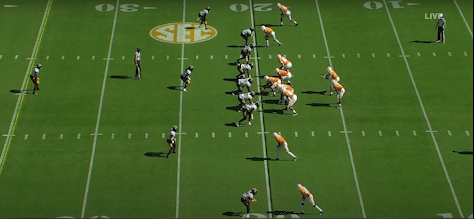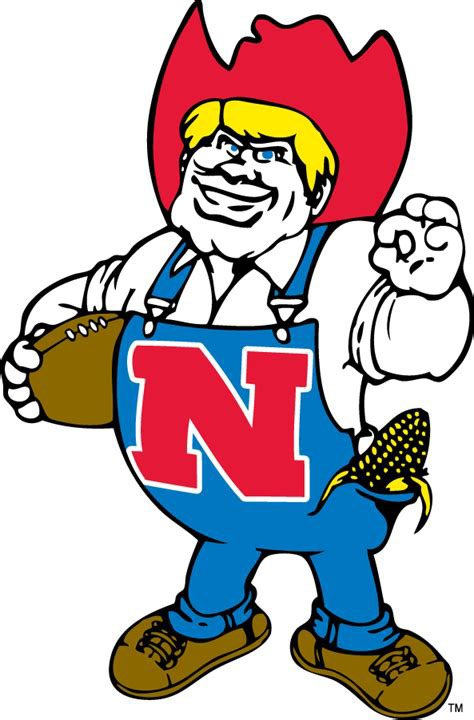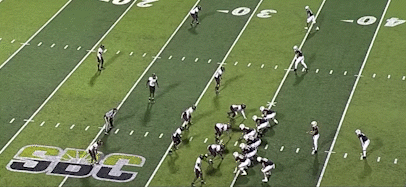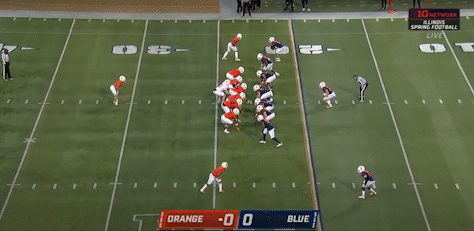Illinois Preview: Nobody Knows What Will Happen
A team with some massive question marks goes against a debut staff that's sworn off everything it's done before
Every season opener comes with its own set of unknowns and questions. Nebraska’s kickoff Saturday against Illinois at 12:20 on FOX is going to come with a lot more than normal.
There will be plenty of mystery regarding the Huskers themselves: Have any Big Ten-caliber running backs or receivers been developed in the past year? Was 2020’s defensive success a sign of real growth or just better luck? Is our head coach good at his job? Were the various offseason kerfuffles minor embarrassments/misunderstandings or a sign of wider disfunction? ARE WE BRINGING BACK THIS TERRIFYING OLD HERBIE???
These are all big and important questions!!!
But plenty of mystery comes from the opposing sideline, too, with a brand new coaching staff leading its first game for Illinois. Nebraska fans are familiar with the new head man; from 2006 to 2012 as head coach, Bret Bielema helped create the Wisconsin road-grader that has ripped Nebraska apart since it joined the Big Ten. His final game with the Badgers — before leaving pre-bowl game for a less successful tenure at Arkansas — was an absolute humiliation of the Huskers in the Big Ten Championship Game that I am DEFINITELY NOT GOING TO LINK TO. We all know this guy.
But this isn’t the same Bielema. At least, he’s saying it’s not. He’s talking about using tempo. He’s talking about using balance. His defensive coordinator said he’s never run the defense he’ll debut Saturday. And on top of that, this a road conference game to open the season — no warm ups this year, just a power-running team like a baseball bat right into your shins.
No one know what’s going on here.
As this is the first preview I’ve done for the newsletter, a brief note on the format: I’ll break down each preview into three categories for the opponent: a very brief look at the personnel (strong and weak units), followed by more in-depth looks at their offense and defense. The sections on the offense and defense each get into their coordinator/play caller’s history, break down the main parts of their schemes, and address how Nebraska might attack/defend them. Let’s get started
ILLINOIS’ PERSONNEL
THE GOOD
The Offensive Line, Running Backs, and Tight End
Illinois’ three best returning offensive players per Pro Football Focus are offensive linemen — center Doug Kramer and tackles Alex Palczewski and Vederian Lowe — and they’re now coached by a guy known for having incredibly baller offensive lines. Tailback Chase Brown returns after a productive third-team All-Big Ten sophomore season, though some of the underlying numbers say he wasn’t quite that good, and senior backup Mike Epstein had similar production on fewer carries. Nebraska fans should be familiar with both after the two ran for a combined 223 yards on NU last season. Tight end Daniel Barker is the team’s top returning pass catcher after Josh Imatorbhebhe left for the NFL. Barker is a decent athlete but struggles with drops and is a poor blocker.
BAD UNITS
Everything Else, but Especially the Secondary
Illinois secondary was the fourth-worst among Power 5 teams last year and, as will be detailed in the defensive breakdown below, is probably going to be left on a lot of islands. Quarterback Brandon Peters can keep the trains coming on time with good players around him, but he doesn’t bring a lot to the table himself, and he’s throwing to the what PFF expects to be the worst receiving corps in the Big Ten. The defensive line is ranked 13th in the conference by PFF, too.
ILLINOIS’ DEFENSE
COORDINATOR/PLAY-CALLER:
Ryan Walters
Walters takes over the Illinois defense after a three-year run at Missouri as defensive coordinator and a six-year overall stint with the Tigers. Hired by Gary Pinkel, he was kept on staff by Barry Odom and then Eli Drinkwitz. His first two units as coordinator finished 25th and 17th in SP+ before a dip last year to 50th. Seems pretty impressive!
For an unfortunate Husker connection, Walters played collegiately at Colorado, starting at free safety in 2007 and 2008. Walters forced one of Nebraska’s three fumbles in the 65-51 loss in ‘07 that was Bill Callahan’s final game as head coach. His dad, Marc, was a CU reserve quarterback in the late 80s, also.
SCHEME:
Base 3-3-5 Tite/Bear, Cover 1
This is where previewing a brand new staff in Week 0 gets a little tricky. Walters said Monday that the Illini’s defense will be “something (he’s) never done.” That could be coach speak to throw off an opponent’s preparation, or it could be a genuine sign of this being a collaborative, new unit. The Illini almost exclusively ran Walter’s Missouri scheme during the spring game and I doubt he’d throw out what’s worked for him before, so I’m leaning toward the former.
With the Tigers, Walters worked in a base 3-3-5 defense (three down linemen, three linebackers, five secondary players) and primarily employed a “Tite” front on standard downs. The Tite front has skyrocketed in popularity at the college level after Iowa State’s and LSU’s success using it to stop spread offenses the last few years. The Tite front employs a true nose tackle head up over the center (a “0” technique) and two defensive ends lined up just outside the guards (“3” techniques). Unless the offensive formation was spread wide, Walters also frequently walked down the outside linebackers into “5” or “7” techniques just outside the tackles to form what was essentially a five-man “Bear” front. It looked like this:

Missouri under Walters played Cover 1 on 58 percent of their snaps last year according to PFF, more than anyone else in the country. They accounted for 2.5% OF ALL COVER 1 SNAPS PLAYED IN THE FBS LAST YEAR. It’s quite possible this dude loves Cover 1 more than anyone else alive. So expect to see a lot of man coverage on all five of the eligibles, with one deep safety in zone in the middle of the field, as shown in the diagram. A good giveaway Saturday that Illinois is in Cover 1 is if you see a single deep safety lined up all the way out to Mars like he is above.
To generate pressure at Mizzou, Walters favored overload blitzes (using stunts/twists or late motion to get more rushers to one side of the formation than the offense has blockers), lining rushers up in wide alignments like 7s and 9s to get angles at the quarterback, and sim pressures where the defense suggests bringing heat with linebackers or secondary players before dropping them back into coverage. Below is a screenshot of a typical third down look Nebraska may expect to face Saturday:
Notice the edge rusher at the bottom of the screen stood-up in a Wide 9 alignment with only two down linemen and the Mike linebacker — that’s Kansas City Chiefs second-round draft pick Nick Bolton — mugged up in the A gap. Only three people on the Missouri front ended up rushing on this play.
HOW NEBRASKA’S OFFENSE CAN ATTACK IT:
If Walters does bring this Tite/Bear front look with him to Illinois, Nebraska will likely try to attack the edges with its ground game. With its packed-in 0 technique and two 3 techniques, the Tite front developed, in part, to take away the “B” gaps — the offensive gap between the guards and the tackles — that traditional four-man over or under fronts gave up and that spread offenses routinely attacked in the running game with plays like inside zone. If they’re seeing a lot of Tite/Bear front, look for Nebraska’s coaches to employ a lot of outside zone, traps, jet sweeps, pin-and-pull, toss, swing passes, or quarterback runs with a lead blocker to the edge to take advantage. Also look for them to use a lot of spread-out formations to get the walked-up linebackers out of the box and in coverage.
Against Cover 1, Nebraska will likely try to exploit the one-on-one coverage on the outside by taking some shots down the field to its receivers. Playing that much Cover 1 works if you have good/great corners, but, as discussed above, Illinois has one of the worst secondaries in the conference. This could be a big debut game for wide receiver Omar Manning; similarly built big, physical X receivers like LSU’s Terrace Marshall Jr. and Tennessee’s Josh Palmer ate alive Mizzou’s secondary last year when left in single coverage. That was a big part of both of those teams’ gameplans against Walters’ defense:

If the corners are playing off to prevent getting beat over the top in man — as they did at Missouri — curl and comeback routes should be effective, too, as should any smash or slot-fade concepts that take advantage of the single-high safety and attack the green areas of the alignment outside the numbers. And look for a few of the other traditional man beaters — mesh, drag routes, double slants, switch/wheel routes, bunch formations, etc. — to be employed as well. Against the third-down unbalanced pressure looks, both LSU and Tennessee both attempted to throw wide receiver screens to the side they had numbers — with spotty results — but that makes some sense, too. Quarterback scrambles could especially hurt the Illini, too, as man coverage defenders lock their eyes on their receivers and can’t see the line of scrimmage. It will be interesting to see if Illinois deploys zone defense more often or uses a spy as a way of hedging against Adrian Martinez’s scrambling ability.
OVERALL:
Considering that Illinois spent most of its spring game running Walters’ exact Missouri defense and I doubt he’d waste valuable spring reps on an elaborate ploy to get an advantage for one week against NU, I’d say the talk of something new from him is largely bologna:
The Tite/Bear front and Cover 1 are both frustrating to play against for spread teams because of the pressure they put on winning individual matchups both on the line and at receiver. But they also come with a downside of giving up chunk plays if an offense can win those matchups and get past the initial level of the front or coverage. Nebraska will likely need to hit some big plays to win this game. We’ll see if those new receivers and backs are ready.
ILLINOIS’ OFFENSE
COORDINATOR/PLAY-CALLER:
Tony Petersen
Petersen is a seasoned hand, having coordinated offenses at Marshall, Louisiana Tech, East Carolina, and, most recently, Appalachian State in 2020. Petersen likes to pass: He ran a version of the Air Raid at Marshall, Louisiana Tech, and East Carolina (where he was the position coach for Garner Minshew), and, as passing game coordinator at Minnesota from 2000-2006, he helped Bryan Cupito set the school’s all-time passing record. He also had an earlier stint at Marshall coaching quarterbacks and serving as OC for one season on those Chad Pennington-Randy Moss teams. But his lone season with Appalachian State was a bit of a departure: The Mountaineers had three backs combine for over 2,000 yards and finished 18th in SP+ rushing success rate.
SCHEME
Outside Zone/Heavy Play Action (Probably)
It’s unclear what offense Petersen rolls out Saturday. Appalachian State’s run-first, outside zone- and tight end-heavy scheme would seem to be more in line with Bielema’s past, but Bielema has also made noises this offseason about utilizing more balance and tempo than he did at Wisconsin. For what spring game footage is worth, the Illini ran quite a bit of outside zone this spring, while also folding in some of the gap-scheme runs like powers and counters Bielema’s Wisconsin teams were famous for.
If they are (mostly) following the App State formula, expect to see a ton of jet motion, tight ends, shifts, and formations to get to one specific running concept: outside zone. Unlike the more-vertical inside zone or gap-scheme runs, which are generally are designed to hit the B gap — the space between the offensive guard and the tackle — outside zone works a defense horizontally and is aimed to hit outside the tackle. Though cutting back into lanes against an over-pursuing defense is also very effective. It requires an athletic offensive line that can move — linemen start the play engaged and have to move laterally before climbing to the second level — and running backs who can read defenders’ positioning before the snap and leverage after it to find holes and cutback lanes. It’s become the offensive scheme du jour in the NFL in recent years, thanks in large part to Kyle Shanahan, whose dad, Mike, made the scheme famous with the Broncos in the 90s. App State had been running this same scheme with MAJOR success for years before Petersen got there — previous coaches or OCs like Scott Satterfield and Eli Drinkwitz used it to get big jobs — so I’m remiss to give Petersen too much credit for using it well for one year. But it’s also hard to run the play better much than this:
Petersen/App State dressed it up in about every possible way — they lined up mostly in the gun or pistol but also ran it some out of the the I or in single back, as well — and tried to get the defense thinking about a lot of things with motions and shifts. But it all always came back to outside zone.
Outside zone also influenced the passing game. A big reason the OZ scheme has become so popular in the NFL is the the separation it can get you in the pass game by running play action boots and downfield shots off run actions. With the linebackers moving horizontally and secondary players having to be extra vigilant against the run, you can hit some MASSIVE plays off a run fake. The huge windows and easy reads it provides make it a great system to (a) prop up an average or bad quarterback like Jimmy Garoppolo, and (b) make a great quarterback like Aaron Rodgers go nuclear. If Petersen is bringing the outside zone scheme with him to Illinois, expect a bunch of stuff like this:
Last year, Petersen called play action at the 23rd-highest rate in the country, and App State finished eighth nationally in Deep Pass Percentage per PFF. Illinois ran quite a bit of boot action in its spring game.
Using a lot of play action was a staple of Bielema’s stops, as well, so look for that big-time on Saturday. In passing or third down situations, App State ran a lot of trafficy man-beaters like mesh and bunch formations. Not dissimilar from Nebraska’s offense, as detailed in the newsletter earlier this week. It rarely messed with screens
HOW NEBRASKA’S DEFENSE CAN STOP IT:
Setting the edge and keeping gap discipline will be huge for NU in this game. The best way to neutralize an outside zone play is to keep the ball carrier moving east-west and not let them cut up the field, and you do that by keeping the linemen moving east-west. Stay square, don’t get turned, and keep your depth. The goal is to try to JUST FORM A F’N WALL and keep the offense’s big guys from getting to the second level — freeing up your linebackers to read the play and drag it out.
Nebraska’s front personnel is pretty well suited for that; having massive dudes at defensive end who aren’t easily moved but are still athletic enough to slide laterally with the play is the ideal (*cough* Ty Robinson *cough*). Also don’t be surprised to see Nebraska’s edge players lining up in wider than normal, or for slot pressures like the below to be used to stop OZ or the boot action off of it.

In coverage, look for NU to line up in coverages that have have flat elements and keep secondary players involved in the run game, specifically Cover 2 and Cover 3. Both are strong options against lateral running team.
OVERALL:
I’m a lot more inclined to believe Illinois’ coaches on offense when they say they’re going to run something new. I think we’re going to see a lot of the moves Petersen picked up with App State, combined with the stuff Bielema (a defensive line coach by origin) likes to run. With Illinois having a good offensive line and good backs, that seems like a formula to move the ball a bit, at least on the ground. I’m a lot more skeptical of the Illini’s ability to pass the ball with Peters.
A Brief Season-Opening Note
This seems like a massive game. It is a massive game! But try not to put too much stock into what happens in one week of football. Iowa State lost by two touchdowns to Louisiana in Week 1 of last year, then ripped off its best season in school history. Tennessee looked like it was a contender in the first few weeks of 2020; now it has a new coach. Football teams and seasons are a collection of 12 (or more) data points. Let’s all not try to get too high or low off of one game and all remember this is supposed to be fun.
GBR
PROGRAMMING NOTES
This will be the ONLY PREVIEW POST THAT GOES TO NON-SUBSCRIBERS. If you want to get future previews before the game (and all of the newsletter’s other great content) delivered to your e-mail inbox, smash that subscribe button below (totally free!!! zero cost!!!). The preview posts will go up on the website after the game.
The newsletter has a Twitter account now! Give @B41FlashReverse a follow for some additional comment and bonus material that doesn’t make it into the newsletters.
Thanks again for reading. If you aren’t subscribed, LET’S GO WHAT ARE YOU WAITING FOR. And if you are, share with any friends who might enjoy!











